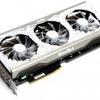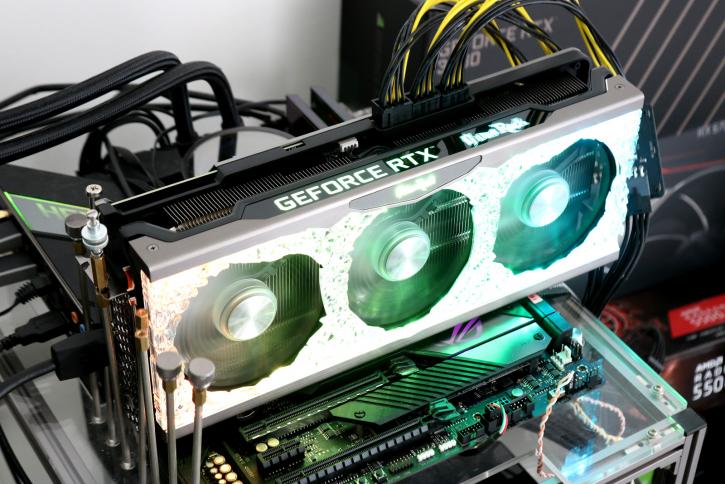Final words and conclusion
Final words
Granted, the Palit GeForce RTX 3080 Ti is a lot to take in once you first look at it with all that bling. However, once powered and feeding that RGB, it does look unique. There's a lot to say for this card, acceptable acoustics levels, normal temperatures, and more widespread power usage. In the end, all that design did not bring in a lot of additional performance; the card is running 50W extra seen from reference (350W) yet manages to increase overall framerates by 1 maybe two percent. It did tweak well manually, though, but more on that later. I'll keep saying this, but it is a bizarre time to write reviews on graphics cards with the shortages and insane price hikes related to that. Really what the market needs are affordable, high-performing graphics cards that sit well under the 500 USD marker. The 3080 Ti does fall into a very premium niche and likely will be hard to get. The good news is that the new NVIDIA SKUs are mostly hash-rate limited on the AIB side, preventing cryptocurrency miners from dominating sales. The reality, however, is also that NVIDIA can only fabricate only a certain number of GPUs, and they'll still need to make the call on how much allocation ends up at gamers and how much is intended for other markets. We hope NVIDIA will make wise decisions because if the trend continues, the PC gaming market will die off as they need to realize what software houses will invest in PC gaming if that market is on a sharp decline?
Performance
Overall the GeForce RTX 3080 Ti is second to that flagship product, blazingly fast on all fronts, and (based on MSRP) is the cheaper card to get. The SUPRIM offers roughly 5% additional performance seen from FE straight out of the box; the card has been tweaked for you already. The 12GB GD6X memory is well balanced; we never understood the expensive 24GB on the 3090, to be brutally honest (not that I mind or don't find it awesome). Overall though, this is a small powerhouse. This card can run games at 4K quite easily with raytracing and a DLSS combo; it will serve you well at that resolution. The closest product from the competition would be the Radeon RX 6900 XT. NVIDIA, however, offers faster raytracing performance and offers you the option to put that into 6th gear with DLSS.
Cooling & noise levels
Depending on the airflow level inside your chassis, expect the card to hit 70 to 75 Degrees C range temperature-wise under hefty load conditions; this value will depend a little on your chassis and airflow. The noise levels hit roughly 41 DBa; while that sounds like a lot, it's more the airflow creating that DBA value; we did not find the card to be particularly noisy or anything; normal would be the wording I like to use here. The two combined to leave a normal impression. As mentioned this card has a dual-BIOS with a performance fan mode and a silent fan mode. Despite listing two different BIOSes and even after driver reinstall, we could not detect any difference between the two BIOS modes. We suspect that this early sample unit has a similar BIOS values.
Energy
The power draw under intensive gaming for GeForce RTX 3080 Ti remains to be significant. We measured it to be close to the 400 Watts for the GameRock OC. This is the tradeoff for a bit more performance for this graphics card (1~2%). The card can easily perform better at default; however, Palit restricted the Boost frequency towards 1725 MHz; ergo, it's hitting a limiter. Are we happy with that amount of energy consumption in the year 2021? No, not at all. Will you, as an end consumer, care about it? We dispute that as well. Keep in mind you'll need a power supply with three 8-pin PCIe graphics power headers. We advise a 750 Watt model as the rest of the system needs some juice, and you will want some reserve. You can increase the graphics card power consumption by another ~40 Watts when you open up that power slider (110%). Yes, that's ~440 Watts of power consumption just for this graphics card when you flick open all registers manually. Heat output and energy consumption are always closely related to each other as (graphics) processors and heat can be perceived as a 1:1 state; 100 Watts in (consumption) often equals 100 Watts of heat as output. This is the basis of TDP. NVIDIA is listing their TGP at 350 Watts, which the GPU and major components use. We measure the graphics card based on TBP, total board power, as you'd easily forget that fans spinning and RGB also draw power. As such, in peak load conditions, we're hovering at roughly 400 Watt state for typical power draw.
Coil whine
Much like the 3080 and 3090, the GeForce RTX 3080 Ti does exhibit coil squeal. Is it annoying? It's at a level you can hear it. In a closed chassis, that noise would fade away in the background. However, with an open chassis, you can hear coil whine/squeal. Graphics cards all make this in some form, especially at high framerates; this can be perceived, albeit we heard very little of it on this Palit card.
Pricing
NVIDIA is pricing the GeForce RTX 3080 Ti at USD 1199. The good news is that that is cheaper than the price of the RTX 3090, while in most scenarios, you are at close to that performance. We do expect AIB cards to be more expensive, as that is a trend as of late. We'll have to wait and see how that pans out, though, as everything is dependant on the actual volume availability of these cards. We can say so little about pricing these days.
Tweaking
The card actually tweaked really well for an RTX 3080 Ti. We've been able to push the power limiter by another 10%, then added 150 MHz on the GPU clock resulting in observed boost frequencies towards ~2050 MHz (depends and varies per game title/application). The memory was binned as well; never have we breached 2.1 GHz on GDDR6X stable. All that combined brings us a 5 maybe 6 % performance premium seen from the reference model, but at the cost of a card now consuming ~440 Watts at a typical load.
Conclusion
Little is wrong with the GameRock OC; we did expect a little more performance though at the 400 Watt power budget; however, Palit remained conservative on the turbo frequency at 1725 MHz. The card can be easily tweaked though to values extending performance towards roughly 5or 6% additional performance, and that is nice. As explained, we're fine with the heat signature we see and measure from this card, the dba levels are a little high, but sometimes airflow can be registered by the dba meter, while it remains more silent. This is the case with this card as we cannot tag it as a loud card whatsoever; you will however hear some airflow. Of course, the looks are debatable, granted this is a lot of bling and crystals, but once RGB powers on, it doesn't look bad at all, But that's a matter of taste and opinions. In general, I think anyone would agree with me; we all would love to own a 3080 Ti. This is a very well-balanced enthusiast-class graphics card. Basically, it's almost a 3090 with half the memory and a few configuration tweaks. I am totally fine with the 12GB memory btw; the 24 GB on the 3090 is impressive but far-fetched and made the product extra expensive. 12GB is a notably well-balanced value in the year 2021. Performance-wise NVIDIA carved out something beautiful. You will be way up there in the highest performance regions, and even at Ultra HD, you can enable Raytracing with the combination of DLSS where applicable. Competition-wise, overall, AMD will still win in the lower resolutions thanks to their massive L3 buffer. However, in more demanding scenarios, NVIDIA takes the lead in rasterized shading performance when the resolution goes up when it comes to brute force muscle power in more demanding scenarios. NVIDIA also has faster Raytracing performance and, of course, the implementation of DLSS that will support that raytracing even further in performance. For raytracing, it's still hard to find Games with raytraced properly reflections, but that's what you should be after, and the numbers will grow in the future. The GeForce RTX 3080 Ti performs well on all fronts, performance, cooling, and acoustics as an overall package of hard- and software.
Palit has a solid offering, but one that you need to like for its aesthetics. It's a grand performer and a very decent tweaker. The one thing we do not know is pricing. The MSRP for the FE cards is 1199 USD; we expect premium cards like shown today normally to be 100 bucks more expensive. However, the market is turned upside-down; ergo, it's hard to write up a conclusion based upon that reality. But if you can find one at a fair price, hey definitely recommended by Guru3D.com.
Sign up to receive a notification when we publish a new article.
Or go back to Guru3D's front page.
- Hilbert, LOAD"*",8,1.


